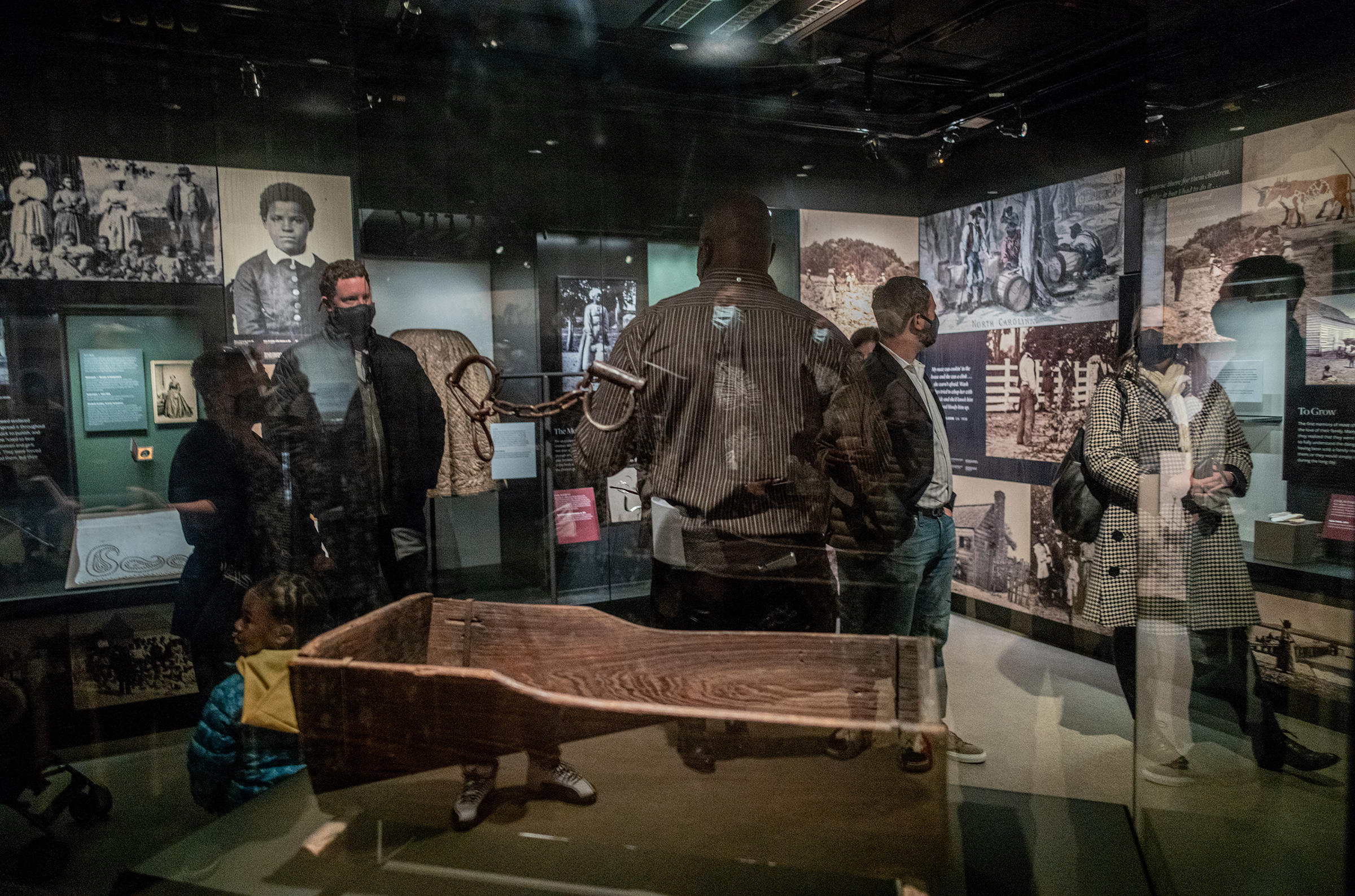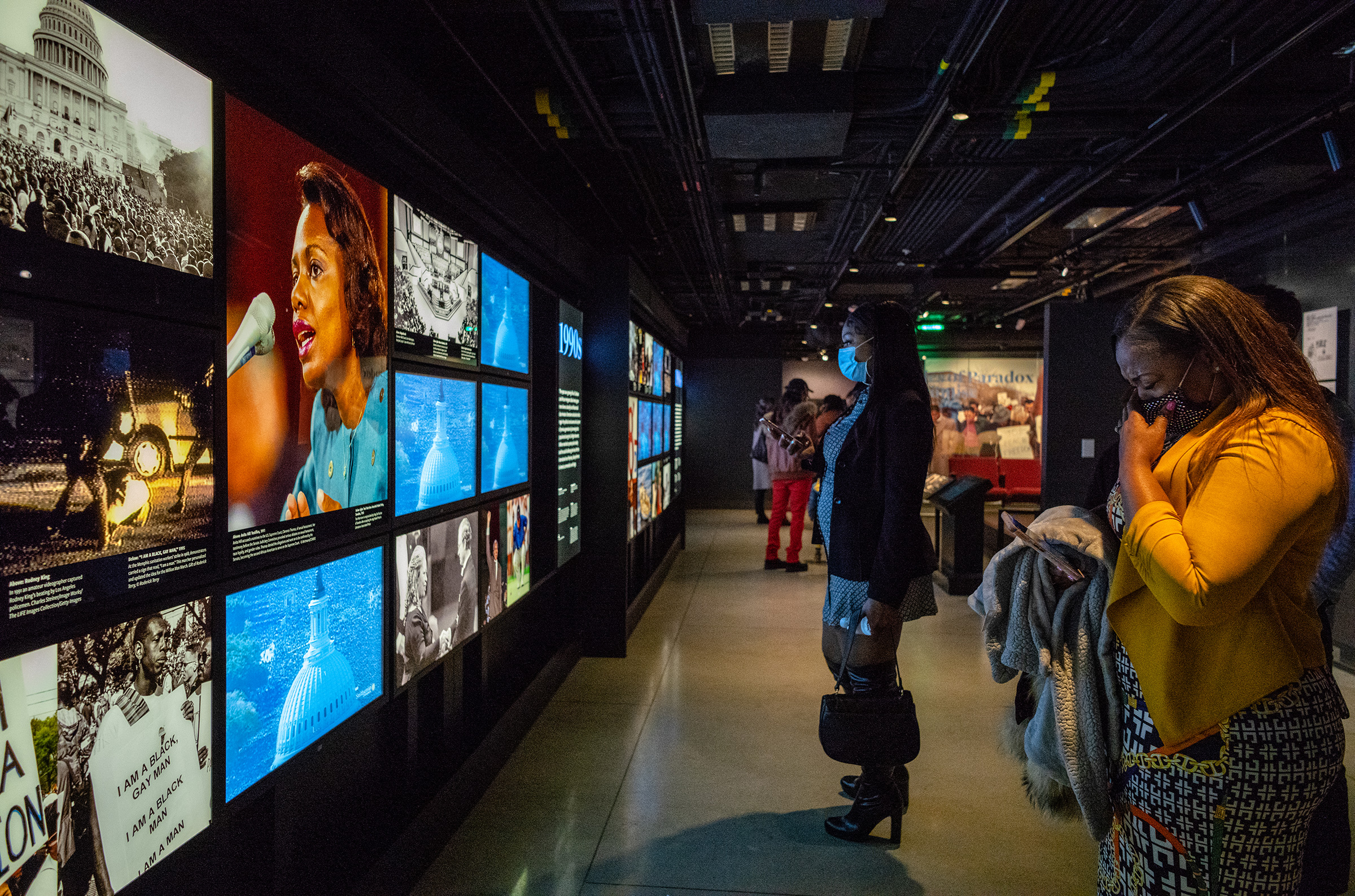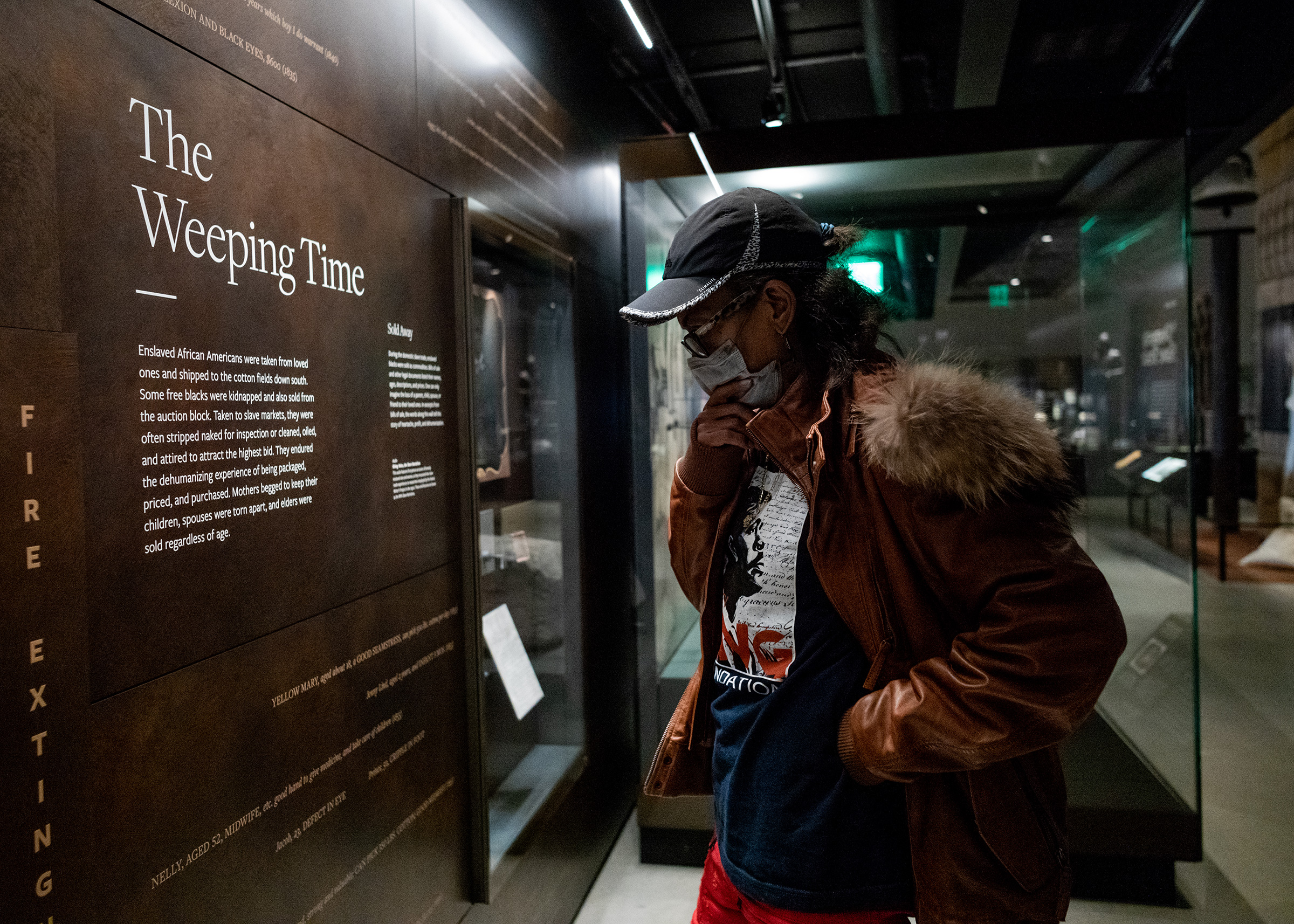
There are the things that happen that people seek to know, and other things they seek to forget. And then, sometimes, for some of us, there are events we feel deep in our bones.
Sunday night, at the Smithsonian’s National Museum of African American History and Culture (NMAAHC) in Washington, D.C., I saw the way these dynamics are at play in the lives of people unwittingly thrust into history. Among the visitors were Lora King, daughter of Rodney King—accompanied by her children as well as her mother, Dennetta Lyles King, an ex-wife of Rodney King—and Bridgett Floyd, sister of George Floyd, and her children. None had visited the museum before, nor had the women previously spent considerable time together.
The women and the museum had been brought together by the Human Gathering, a group that one of its founders, Joshua Jordison, bills as an exclusive social organization that produces vacations, experiences—like museum tours—and social-improvement projects for its members. Some members are currently working to create an investment fund that they say will fund businesses in underserved communities as well as a nonprofit social justice organization guided by King, Floyd, and others who find themselves similarly situated to “leverage” the publicity they cannot avoid, one of the fund developers, Brian Forman, tells me. Several of the people involved in the project are also present. Leading the tour are museum director Kevin Young and Aaron Bryant, a curator with his own stories about the work of preserving history.
Most museums, Bryant tells me the next day, were built by robber barons, new money looking for a path to social standing or just a place to store the treasures from their travels. Other museums exist to memorialize the lifestyles and images of the rich and the royal. But the NMAAHC, which opened in 2016, is there to tell the unvarnished truth, he says. There are times, like the summer of 2020 and the year thereafter, when it can seem that this is a collection of traumas and tragedies, there to answer curiosity or assuage guilt. But the Black story in America is also one of triumph and tragedy, resistance and resilience, ingenuity and endurance. It is one of joy and, yes, pain. The entire museum is complicated this same way. It has to be, Bryant tells me. Black is not merely a subject of study or pity, he says. It is a state of being. It is a verb.

As the group moves through a room that holds the remnants of a Portuguese slave ship, some stop to take in the contents of an eye-level display case. Three sets of shackles. One is so small that the accompanying written description only affirms what anyone who sees them can surmise. They were shackles used to ensnare and enslave a child. Most visitors spend multiple hours in the museum, but this group is moved swiftly toward the 1960s. There, in a long hallway broad enough to also house a set of train cars, sits the lunch counter where students from the North Carolina Agricultural and Technical State University launched their sit-in and inspired others like it across the South. Behind the counter are a series of massive screens playing images captured by news cameras on the Edmund Pettus Bridge in 1965; John Lewis, the future Congressman, has blood spattered on his collar.
Then we enter an area where no photos or videos may be recorded. No exceptions.
The sound of Mahalia Jackson’s rendition of “Amazing Grace” fills a small room. A back wall is covered by an image of mourners at the funeral of Emmett Till. In the center of the room is the bronze-colored coffin in which the murdered teenager was buried in 1955. Inside is an image of Till, in the horrific state in which he was found after two white men kidnapped, beat, and killed him, then submerged his body in a river.
For so many Black Americans, their place in public history involves the worst tragedies their families will ever know and never, ever forget.
Bridgett Floyd sees the coffin and swiftly leaves the room. She takes a seat on a bench just outside. She sits there head down, silent. Lora King is not far behind her, but she moves to a brighter space, home to objects like a yellow dress Rosa Parks was sewing for herself at the time she decided not to budge from her bus seat, helping set in motion the Montgomery Bus Boycott and ultimately the integration of public facilities across the country. Parks had worked as an investigator and secretary for the NAACP. She had seen and heard many awful things—but, she later said, the bravery of Till’s mother Mamie Till-Mobley, who agreed to allow Jet magazine to publish photos of what had been done to Emmett, compelled her on that day.
Years later, in that same room, Trayvon Martin’s father, who had come to the museum on a similar private tour, bore witness to Till-Mobley’s painful choice to let the world see what two white men did to her son, Bryant tells me. Soon, conversations began between the museum and Martin’s parents, Tracy Martin and Sybrina Fulton. The materials that had been returned to them after a Florida jury acquitted the man who killed their teenage son—the hoodie, jeans, and shoes; the can of iced tea and bag of Skittles that he had been carrying when he was deemed suspect, followed, shot, and killed—had become too painful to store in their homes. Yet they could not bring themselves to throw them away.
“I told them that we would take them and keep them safe, forever,” Bryant recalls. To transport the last objects Trayvon Martin touched and wore in this life, the staff at the museum constructed a special case. As Bryant prepared the objects, he says, he wept so hard that Fulton had to comfort him. Despite what was implied during the trial—that Martin was a large man—Bryant says they are very much the things of a scrawny kid. They went on display in September of 2021, in a section of the museum dedicated to the ongoing questions of what birthright citizenship and equal protection under the law actually mean.
King tells me that she had to leave the Till coffin room because “that was heavy—very, very heavy.”
On Sunday night, as we moved toward the museum’s top floor and forward in time, King turned a corner and encountered the source of some of her own personal pain—pain that for many of the rest of us was a terrible national event observed, in some cases felt, but not carried. Just beyond an exhibit about the Poor People’s Campaign, the rise of the Black Power movement and a blown-up June 1974 TIME magazine cover featuring “Middle-Class Blacks” were screens capturing major moments and events of the 1990s and 2000s. And there was the video of Rodney King, on the ground, begging as multiple Los Angeles Police officers beat, kicked, and stomped him after a high-speed car chase. Lora King stood there watching, in silent tears.

The Rodney King beating marked a moment in American history at which the thing that Black people had long said happens all too often was caught on tape by a bystander, eventually making witnesses out of all of us, Bryant later tells me. Standing in front of the video though, nothing needs to be said. Nothing at all. A jury acquitted the officers on state charges, setting off the 1992 L.A. Riots. During them, the press turned to Rodney King. “I just want to say, can’t we all get along? Can’t we all get along?” he famously said.
“If we could find a way to get along, imagine where we could be,” Lora King, 38, says now. “The United States, like it or not, is an example watched by the entire world.”
On Sunday evening, inside the museum, as King’s daughter stood watching the footage of her father’s ordeal, it was Bridgett Floyd who wrapped an arm around King’s waist. The two women slowly walked away, supporting one another.
“[Seeing the tape in the museum] hurt my soul but at the same time, it inspired me,” King says. All these years later, what happened to her father when she was only 7 years old continues to shape her everyday experiences. She’s been in gyms, at parties, and in all sorts of awkward places where the tape is played or the King beating is brought up. “I want people to understand that: that’s a pain that’s unforgivable, unforgettable.”

The evening at the museum, King tells me later, made her tired—a sensation she rarely allows herself to feel.
“Who am I to be tired? I try to give myself some time to flash back to what our ancestors experienced [in slavery],” King says. She allows herself time when she needs it. She runs a foundation. She is working to stem gang violence and connect people with mental health care. She operates seasonal food and toy banks. And her family has been through far more than most know: She is also a cousin of James Byrd Jr., the Texas man dragged to his death by a trio of white men in 1998. “But I don’t really allow myself to be tired, to say I’m tired. What we experience is not perfect but does not compare. There were babies being worked in fields, babies being raped,” she says. “So, I can truly say, Sunday, that was the first time in a long time I’ve said out loud, I’m tired.”
Tired, she says, that 30 years after her father’s ordeal, his plea for harmony remains unrealized. Though of course, life is more complicated than merely getting along. And King’s 1992 admonition was not received well by all ears even at the time; the phrase, some felt, implied a two-sided conflict with equal responsibility on both sides. The reality couldn’t be further from that: Rodney King was alone, with no gun, on the ground while he was beaten; when he drowned a decade ago, it was after years dealing with permanent brain damage and lingering, untreated mental anguish, his daughter told me. The two men who were acquitted for murdering Emmett Till, after he allegedly flirted with a white woman, confessed their crimes in a magazine. Trayvon Martin went out for candy and never came home. And George Floyd, who could have been merely asked to appear in court for attempting to use an alleged small counterfeit bill, had the life squeezed out of him on a Minneapolis street by a police officer as several other officers watched.
On Sunday, inside the museum, one of the final legs of the tour took the group inside an art-gallery space called Reckoning. Among the works on display are images of the massive protests that followed the May 2020 death of George Floyd, and an image of the Rodney King beating in which, as King’s granddaughter put it at first sight, “Grandaddy is missing.” The artist cut the shape of King’s body out of the image leaving an illuminated void.
Around a corner is an intricate quilted portrait of Harriet Tubman, created by the artist Bisa Butler. The dark skin on Tubman’s face is rendered in strips of red, black, and blue silk, velvet, and cotton, creating the effect of a face that has seen and done and endured remarkable things. Across the hall, in a kind of recessed black-walled alcove is a picture, this time a painted portrait by the artist Amy Sherald. It’s Breonna Taylor, awash in blue, bathed in light.
That, King tells me later, is something like what George Holliday, a white man and perfect stranger, did when he picked up his video camera and kept filming as officers beat her father in 1991.
“What he did was shine a light on this thing,” says King. “This horrible thing that yeah, is still with us—but today, that it exists can not be denied. To me that’s an incredible, incredible thing.”
More Must-Reads from TIME
- Cybersecurity Experts Are Sounding the Alarm on DOGE
- Meet the 2025 Women of the Year
- The Harsh Truth About Disability Inclusion
- Why Do More Young Adults Have Cancer?
- Colman Domingo Leads With Radical Love
- How to Get Better at Doing Things Alone
- Michelle Zauner Stares Down the Darkness
Contact us at letters@time.com